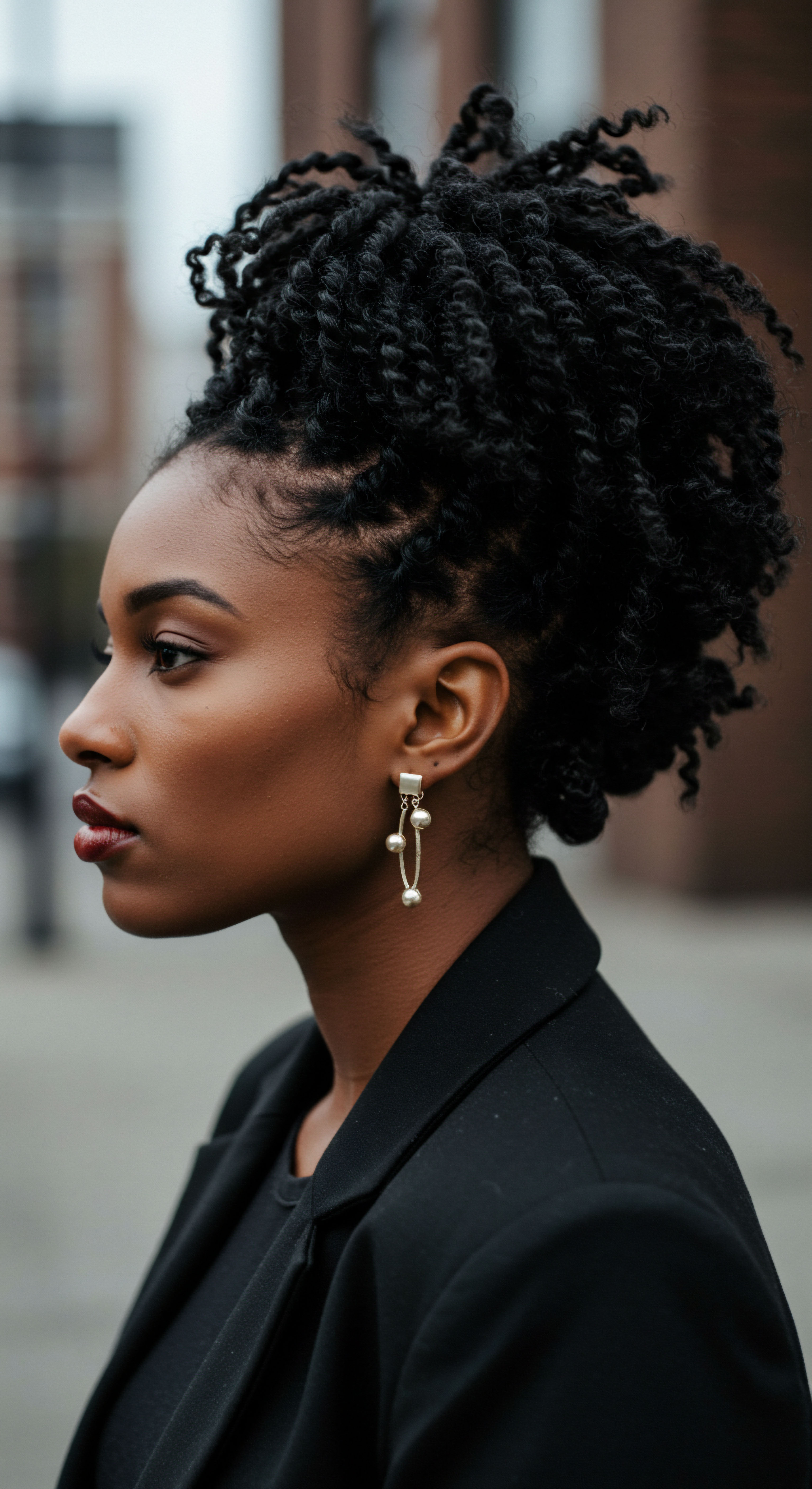
Roots
Consider the quiet dance of water, an elemental force that shapes our world, from the grandest rivers to the smallest droplets that caress our skin each morning. For those of us with coiled hair, this daily interaction with water holds a particular weight, often determining the very disposition of our strands. There is a subtle, often unseen, influence at play within the very liquid we use to cleanse and refresh our hair.
It is a story whispered through the strands, a tale of minerals and their silent, yet persistent, presence. This section delves into the fundamental aspects of this interaction, uncovering the unseen forces that sculpt the daily reality of coiled hair.

Water’s Unseen Passengers
Water, in its natural state, is rarely pure. As it journeys through the earth, it gathers microscopic companions—dissolved minerals. When these minerals, predominantly Calcium and Magnesium, are present in higher concentrations, water earns the designation of “hard.” These aren’t harmful to drink, yet their character shifts dramatically when they meet the delicate structure of coiled hair.
Hardness in water is measured, often in parts per million (ppm) or grains per gallon (gpg), with varying scales defining what constitutes soft, moderately hard, hard, or very hard water. This mineral composition is a quiet architect, subtly reshaping the environment of our hair.
Beyond calcium and magnesium, other metal ions can also contribute to water’s hardness and its impact on hair. These include traces of Iron, Copper, Aluminum, Barium, Strontium, Zinc, and Manganese. Each of these can leave its unique imprint, though calcium and magnesium are the most commonly discussed and prevalent actors in this mineral drama. The presence of these ions is a geological signature, reflecting the subterranean journey of water before it reaches our pipes.

The Architecture of Coiled Hair
Coiled hair, with its unique helical structure, possesses an inherent predisposition that makes it particularly susceptible to the effects of hard water. Each strand is a marvel of biological engineering, comprising a central medulla, a surrounding cortex, and an outermost protective layer ❉ the cuticle. In straight hair, cuticle scales typically lie flat, forming a smooth, relatively impenetrable surface.
Coiled hair, however, often features a naturally more open cuticle, or cuticles that are prone to lifting, especially at the curves and bends of the coil. This characteristic means that coiled strands are inherently more porous, allowing substances to enter and exit the hair shaft more readily than their straighter counterparts.
The surface of hair carries a natural electrical charge. Healthy hair generally maintains a slightly acidic pH, around 4.5 to 5.5, which helps keep the cuticle scales sealed and smooth. Hard water, being naturally alkaline, can disrupt this delicate pH balance. When the hair’s pH increases due to alkaline hard water, the cuticle layers become more negatively charged.
This increased negative charge acts as a magnet for the positively charged mineral ions (cations) present in hard water. This electrostatic attraction creates a powerful bond, allowing minerals to cling to the hair’s surface and even penetrate beneath the cuticle.
Hard water’s minerals, primarily calcium and magnesium, adhere to coiled hair’s naturally open cuticle, creating a persistent film that blocks essential moisture.
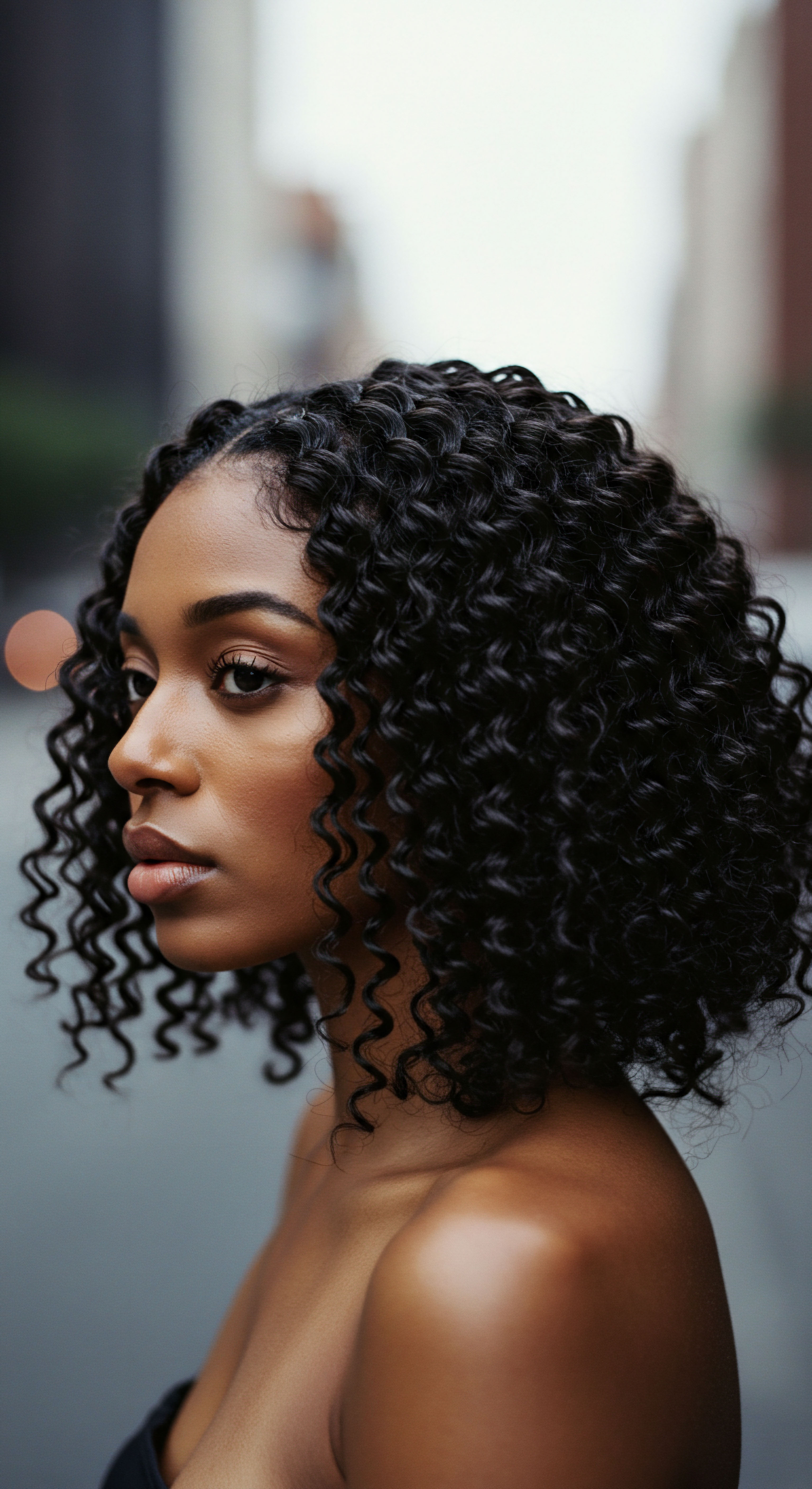
How Minerals Befriend Hair
The interaction between hard water minerals and hair is a molecular handshake, a chemical dance that leaves its mark. When hard water flows over coiled strands, the calcium and magnesium ions readily adhere to the hair’s surface. This attachment is not superficial; these minerals can form a stubborn film, a coating that wraps around each individual strand.
This mineral coating then acts as a physical barrier, making it exceedingly difficult for water and conditioning products to penetrate the hair shaft effectively. The result is a cycle of dehydration, as moisture struggles to reach the hair’s inner core, leading to a cascade of unwelcome changes in texture and appearance.
Moreover, the very act of washing can worsen this mineral adherence. Many hair care products contain fatty acids, which, when combined with hard water minerals, can react to form a scummy, insoluble residue. This residue, often felt as a greasy or sticky film, compounds the problem of mineral buildup, further weighing down strands and preventing thorough cleansing. The effect is akin to trying to clean a window with a dirty cloth; the effort is made, but the clarity remains elusive.
The consequences of this mineral deposition are manifold for coiled hair. Over time, the continuous accumulation of these minerals can alter the hair’s tactile qualities, making it feel rough, stiff, and brittle. This increased rigidity can reduce the hair’s natural flexibility and increase friction between individual strands, which in turn can lead to tangling and even microscopic abrasions on the hair shaft. These subtle damages compromise the hair’s integrity, setting the stage for more visible issues.

Ritual
Stepping into the realm of practical understanding, we turn our attention to the daily and periodic practices that shape the lived experience of coiled hair under the influence of hard water. It is here, in the quiet moments of wash day and styling, that we seek gentle guidance, transforming awareness into intentional action. The wisdom of ritual, both ancient and modern, offers a path to mitigating the persistent presence of minerals, allowing our strands to breathe and flourish.

Reading the Signals Your Hair Sends
Before devising a response, it is helpful to recognize the signs that coiled hair exhibits when contending with hard water. These signals are often subtle at first, becoming more pronounced over time.
- Dryness and Frizz ❉ Despite regular conditioning, hair feels perpetually parched and struggles to retain moisture, leading to an amplified halo of frizz.
- Dullness and Lack of Shine ❉ The natural luster of coiled strands diminishes, replaced by a lackluster, almost hazy appearance, as minerals coat the hair surface and prevent light reflection.
- Stiffness and Brittleness ❉ Hair loses its characteristic suppleness and elasticity, becoming rigid to the touch and prone to snapping or breaking during manipulation.
- Tangles and Difficulty Detangling ❉ The roughened cuticle surface, a consequence of mineral deposition, causes strands to catch on one another, making detangling a frustrating and often damaging ordeal.
- Reduced Product Effectiveness ❉ Shampoos may struggle to lather adequately, and conditioners seem to sit on the hair’s surface without truly hydrating, requiring more product for less effect.
- Scalp Irritation ❉ An itchy, flaky, or generally uncomfortable scalp can be a tell-tale sign, as mineral buildup can clog follicles and disrupt the scalp’s delicate balance.
- Color Alteration ❉ Color-treated hair may fade more rapidly or develop unwanted brassy, orange, or even green tones, particularly noticeable in lighter shades.
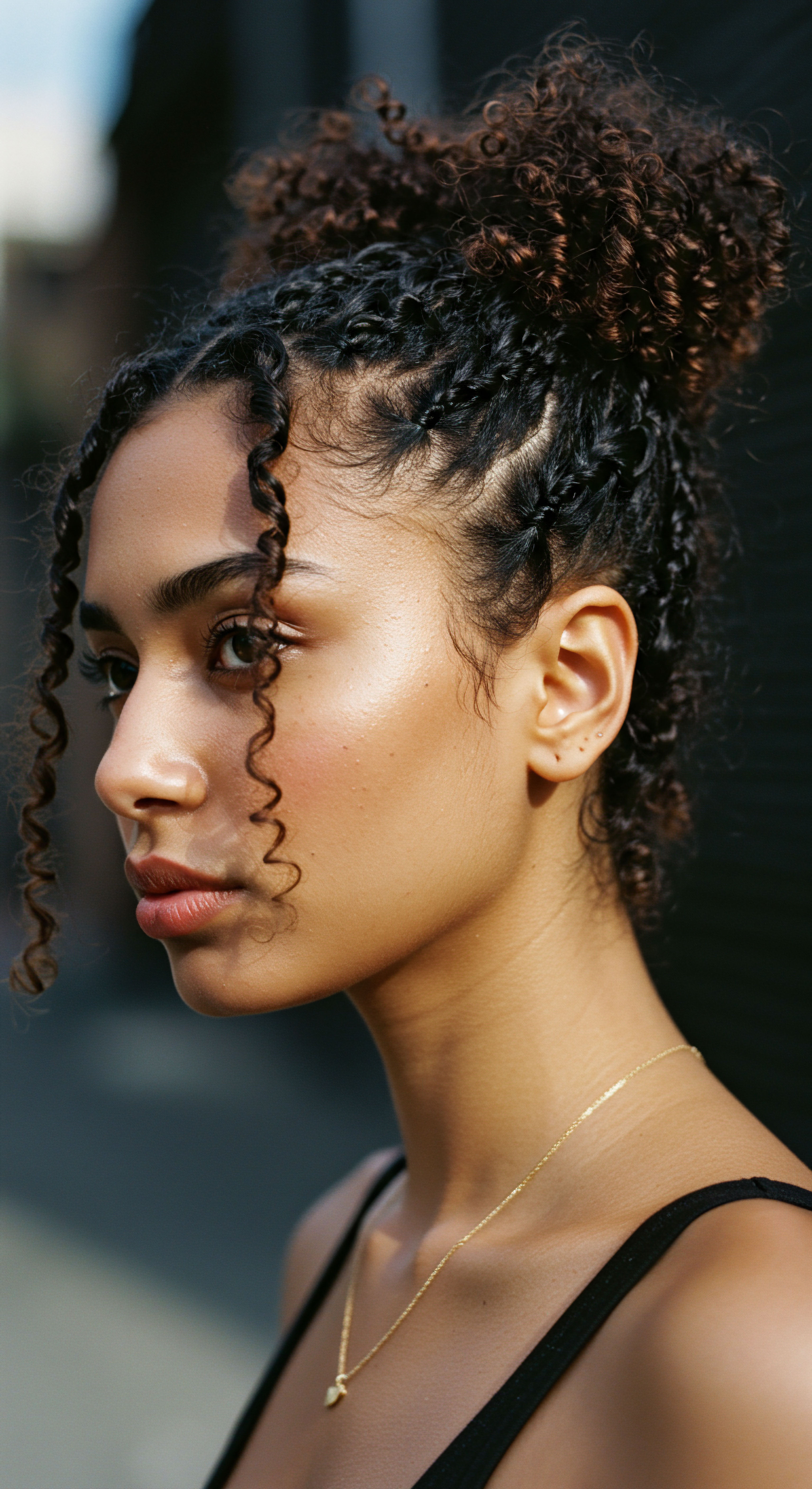
Chelation as a Cleansing Practice
The cornerstone of managing hard water’s impact on coiled hair lies in the practice of chelation. Chelating agents are specialized ingredients that bind to metal ions, effectively capturing them and allowing them to be rinsed away from the hair. This process is distinct from regular cleansing, as it specifically targets the mineral bonds rather than just surface dirt and oils.
Dedicated Chelating Shampoos are formulated with potent ingredients such as EDTA (Ethylenediamine Tetraacetic Acid) and its salts (Disodium EDTA, Tetrasodium EDTA), or Pentasodium Pentetate. These compounds are designed to actively seek out and sequester the mineral ions, preventing their attachment to hair and removing existing buildup. For a gentler, more accessible approach, some natural acids also possess chelating properties.
Citric Acid, often found in lemon juice, and Acetic Acid, the active component in vinegar, have been recognized for their ability to bind with mineral deposits, particularly calcium. A rinse with diluted apple cider vinegar, for instance, can help to dissolve some mineral film and restore the hair’s natural pH balance.
The frequency of using chelating treatments depends on the severity of your hard water and your hair’s response. For some, a monthly or bi-monthly chelating wash may suffice, while those in very hard water areas might find a more frequent application beneficial. It is important to listen to your hair and observe how it responds, adjusting the ritual to its unique needs.
Regular use of chelating agents, whether in specialized shampoos or natural rinses, helps detach hard water minerals from hair, restoring its vibrancy.
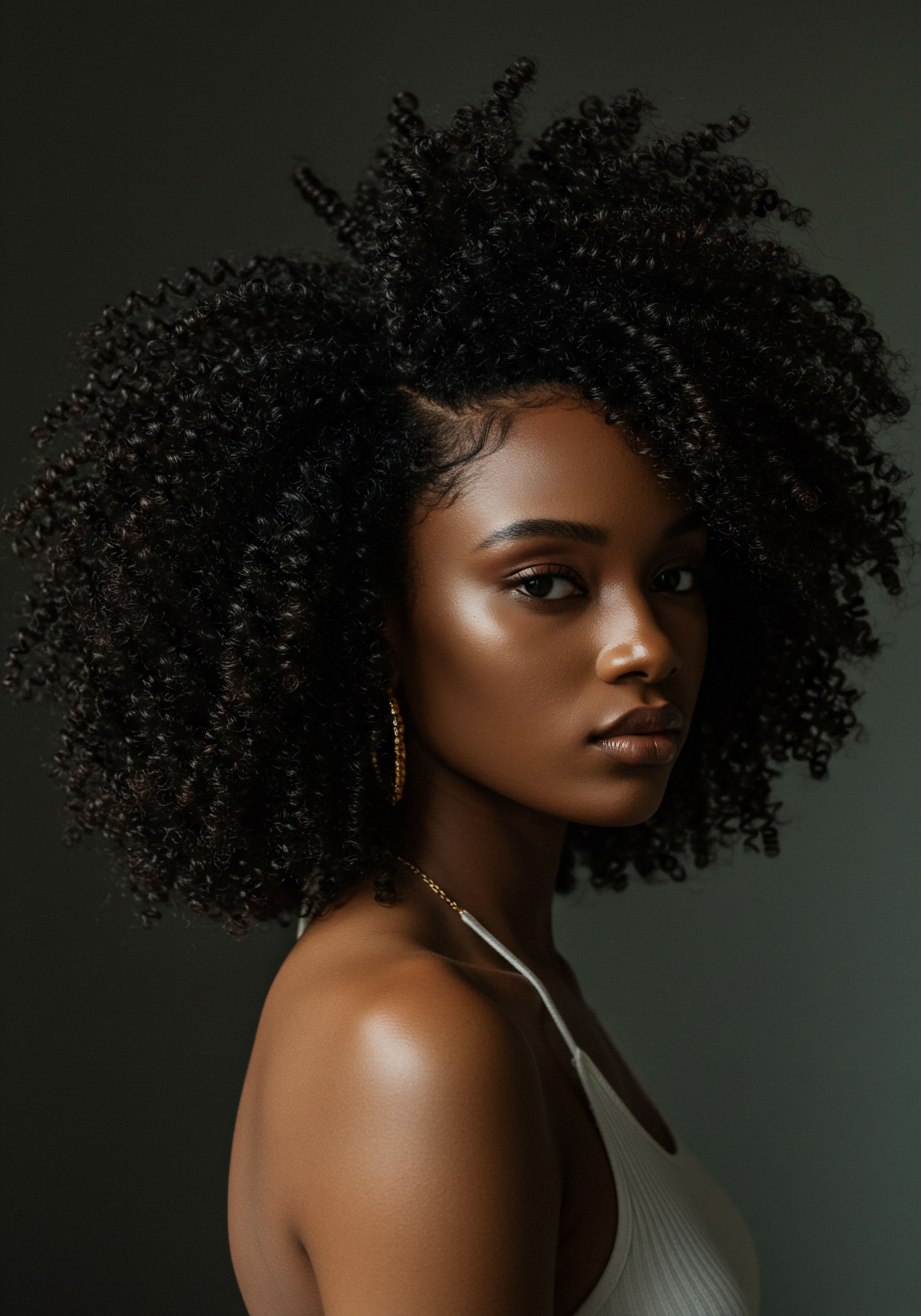
Hydration and Sealing
Once minerals are removed, the hair’s ability to absorb moisture improves dramatically. This is the moment for intensive hydration. Coiled hair thrives on moisture, and hard water often robs it of this essential element. Deep conditioning treatments become even more vital in a hard water regimen.
These treatments, rich in humectants and emollients, help to replenish lost moisture and smooth the hair’s cuticle. Applying deep conditioners with mild heat, perhaps under a warm towel or a hair steamer, can further assist in opening the cuticle and allowing for deeper penetration of conditioning agents, especially for those with low porosity hair.
Following hydration, sealing the moisture within the hair shaft is a crucial step. This can be achieved using heavier oils or butters, which create a protective barrier that helps to lock in the moisture and shield the hair from environmental stressors, including the re-deposition of minerals. This layering approach ensures that the hair remains supple and resilient between washes, resisting the drying and stiffening effects of hard water.

Considering Water Quality at the Source
While chelating treatments address the symptoms, modifying the water itself offers a more proactive solution.
- Shower Filters ❉ These devices attach directly to your showerhead and contain filtration media designed to reduce mineral content, chlorine, and other impurities. They can significantly improve hair’s softness, manageability, and overall health by preventing mineral buildup from the source.
- Whole-House Water Softeners ❉ For a comprehensive solution, a water softener system installed at the main water line removes calcium and magnesium ions through an ion exchange process, replacing them with sodium or potassium ions. While more significant in investment, this provides softened water throughout the entire home, benefiting not only hair but also skin and appliances.
The choice of a shower filter or a whole-house softener depends on individual circumstances and the severity of hard water. Even with a water softener, some residual sodium ions may remain, and occasional chelating treatments might still be beneficial.
| Chelating Agent Citric Acid |
| Primary Function Binds with calcium, improves hair integrity |
| Common Forms Powder, lemon juice, ingredient in many products |
| Chelating Agent EDTA (Disodium/Tetrasodium) |
| Primary Function Strong chelator for various metal ions |
| Common Forms Ingredient in many hard water shampoos and treatments |
| Chelating Agent Sodium Gluconate |
| Primary Function Natural chelator, effective for iron and copper |
| Common Forms Ingredient in "natural" chelating products |
| Chelating Agent Acetic Acid |
| Primary Function Helps dissolve mineral film, balances pH |
| Common Forms Vinegar (e.g. Apple Cider Vinegar) |
| Chelating Agent Always dilute concentrated acids and test on a small hair section first. |

Relay
Let us now step beyond the immediate, into a deeper consideration of hard water’s influence on coiled hair, tracing its threads through the tapestry of science, cultural heritage, and the intricate nuances of lived experience. This exploration invites us to peer closer, to discern the less apparent complexities that water quality unearths, drawing connections between the microscopic and the broadly human.
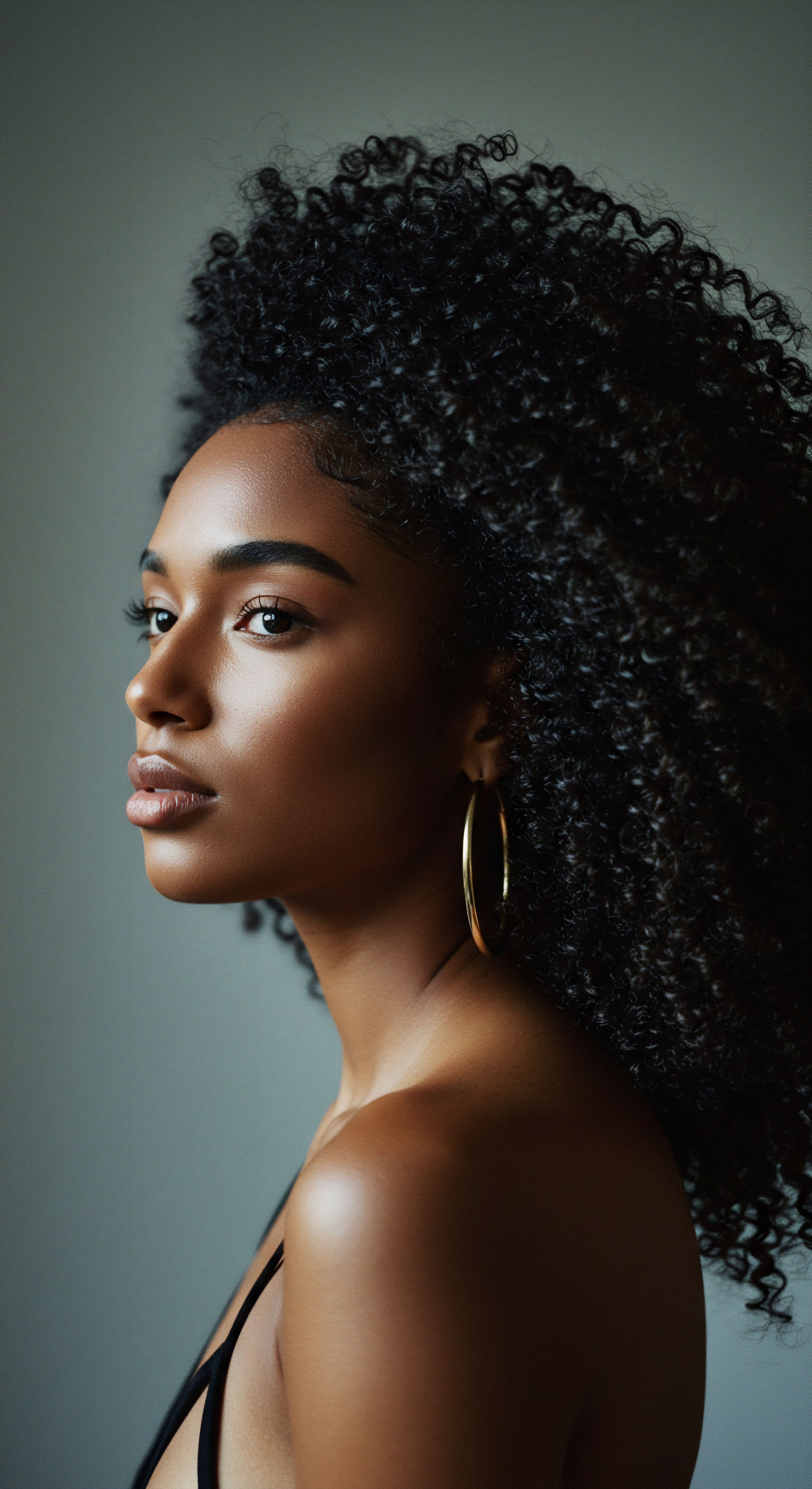
Does Hard Water Truly Weaken Coiled Hair? A Deeper Look
The question of whether hard water directly weakens hair, making it more prone to breakage, is a subject of ongoing scientific inquiry, revealing a spectrum of findings that invite closer examination. While many anecdotal accounts and some studies suggest a direct link between hard water exposure and decreased hair strength, other research presents a more nuanced picture.
A study by Srinivasan and Chakravarthy Rangachari (2013, 2016) offers a compelling point of discussion. Their research, involving hair samples treated with hard water over 30 days, found no statistically significant difference in the Tensile Strength and Elasticity of hair when compared to hair treated with distilled water. This particular finding challenges the immediate assumption that hard water fundamentally compromises the hair’s ability to resist breakage under tension or return to its original shape. However, this same research did reveal a critical, visible impact ❉ the hard water-treated hair exhibited significantly higher Mineral Deposition, notably calcium and magnesium, and a measurable Decrease in Hair Thickness, along with a ruffled appearance of the cuticle.
The mean calcium deposition in hard water-treated hair was determined to be 0.804% compared to 0.26% in distilled water-treated hair, while magnesium deposition was 0.34% versus 0.078%. Furthermore, the mean thickness of hair treated in hard water was 72.78 µm, contrasting with 78.14 µm for distilled water-treated hair.
This presents a vital distinction ❉ while the hair’s intrinsic breaking point might not be immediately altered, the cumulative physical changes to the hair shaft are undeniable. The ruffled cuticle and decreased thickness, coupled with mineral buildup, collectively lead to hair that feels rougher, appears duller, and is more susceptible to mechanical damage from styling, friction, and tangling. It is this altered surface and cumulative physical burden, rather than an inherent weakening of the hair’s internal structure, that often manifests as increased breakage and difficulty in managing coiled hair in hard water environments. This nuanced perspective underscores that the impact is often less about a direct structural compromise and more about the gradual, persistent surface alteration that makes hair more vulnerable in daily life.

The PH Paradox and Coiled Hair’s Vulnerability
The pH of water plays a quiet yet powerful role in how hard water interacts with hair, particularly coiled hair. Our hair and scalp thrive in a slightly acidic environment, typically between pH 4.5 and 5.5. This acidic mantle helps keep the hair’s outermost layer, the cuticle, smooth and closed, acting as a protective shield.
Hard water, by its very nature, is often alkaline, possessing a pH above 7. When alkaline hard water comes into contact with hair, it causes the cuticle scales to lift and become more negatively charged.
For coiled hair, which often has a naturally more open cuticle structure, this effect is particularly pronounced. The lifted cuticles create more surface area for positively charged mineral ions to cling to, accelerating mineral deposition. This increased adherence leads to heightened friction between individual strands, contributing to frizz and tangling.
Over time, this constant lifting and roughing of the cuticle can lead to a phenomenon known as increased Porosity, even in hair that was not initially highly porous. Highly porous hair absorbs moisture quickly but struggles to retain it, creating a perpetual state of dryness that hard water only exacerbates.
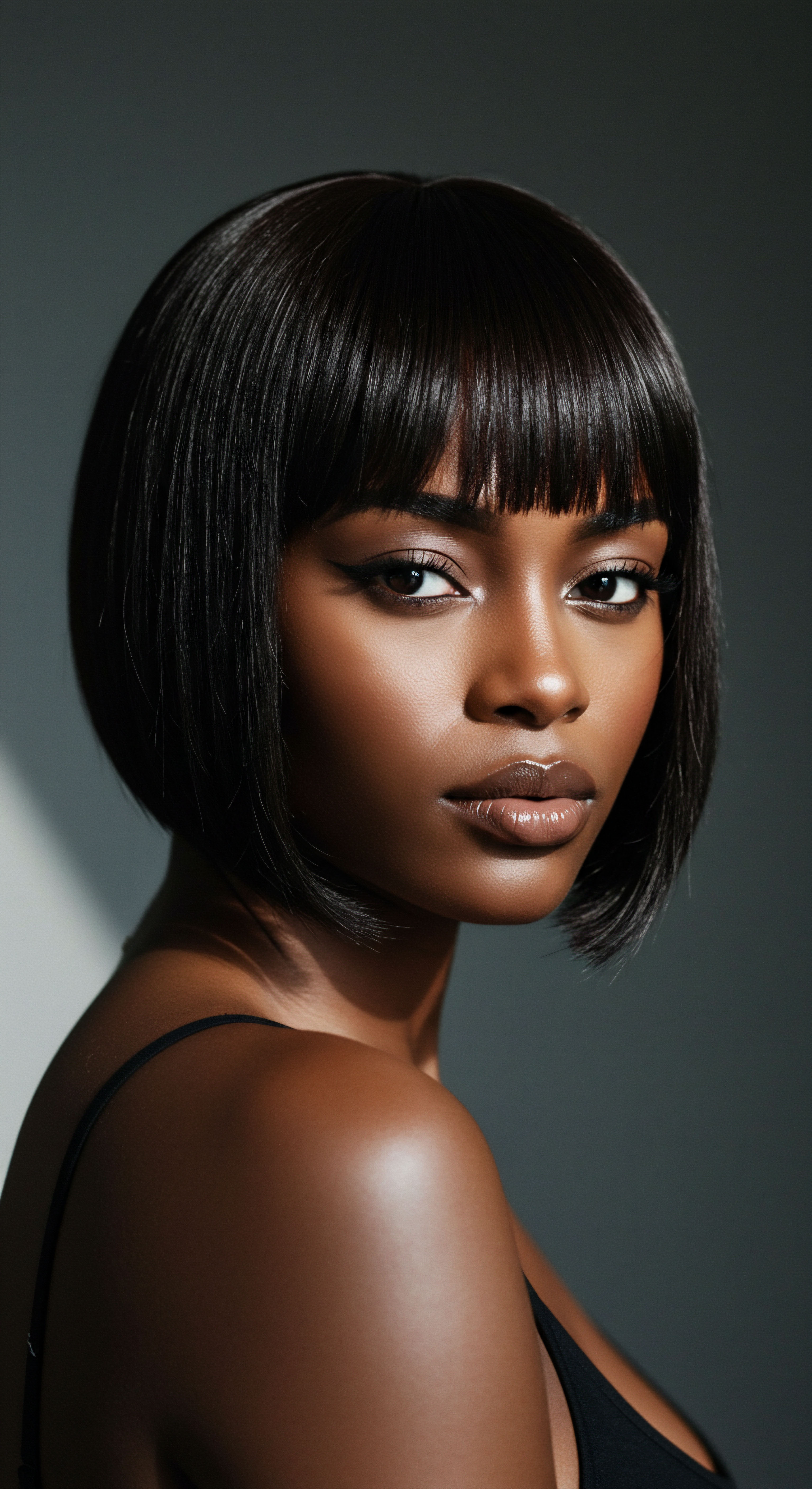
How Does Hard Water Alter Hair Porosity?
Hair porosity, the hair’s capacity to absorb and retain moisture, is significantly influenced by hard water. While genetics largely determine natural porosity, external factors like hard water can profoundly alter it. For those with naturally Low Porosity Hair, characterized by tightly closed cuticles that resist moisture absorption, hard water minerals can create an additional barrier, making it even harder for water and products to penetrate. This results in products sitting on the hair’s surface, leading to buildup and continued dryness despite attempts at hydration.
Conversely, for hair that starts with a more balanced or even High Porosity, the alkaline nature of hard water can cause the cuticles to lift further, pushing the hair towards an even higher porosity state. This makes the hair absorb water rapidly but lose it just as quickly, leading to persistent dryness, frizz, and increased vulnerability to breakage. The mineral deposits themselves can also cause oxidative damage within the hair, particularly in highly porous or chemically treated strands.

A Glimpse Through History ❉ Water Quality and Hair Traditions
The relationship between water quality and hair care is not a modern revelation; it is a narrative woven through centuries of human history and cultural practices. Before the advent of modern plumbing and sophisticated water treatment, communities often adapted their hair care rituals to the water sources available to them. In many historical contexts, clean, soft water was a luxury, not a given.
Consider, for instance, hair care practices in the Middle Ages. The concept of daily shampooing as we know it is a relatively recent invention, emerging in the early 20th century. Medieval people, facing often contaminated or hard water sources and harsh soaps, adopted alternative methods to maintain hair cleanliness and health.
They relied on extensive brushing, headwraps, and styling practices like braiding and pinning up long hair to prevent tangles and breakage. Some historical texts, like ‘The Trotula,’ a collection of medieval medical texts, even contained recipes for hair washes using various natural ingredients, hinting at an awareness of hair needs beyond simple cleansing.
In other cultures, specific water-based traditions evolved. The Yao minority community in Southern China, renowned for their exceptionally long and lustrous hair, traditionally used Fermented Rice Water for washing. This practice, dating back to the Tang dynasty, likely offered benefits beyond simple cleansing.
Fermented rice water is rich in amino acids, vitamins, and antioxidants, which can contribute to hair strength, shine, and manageability. While not explicitly a response to hard water, such traditions speak to a deep, intuitive understanding of water’s potential effects and the use of natural remedies to support hair health, a wisdom that transcends time.
The presence of hard water also carries subtle socio-economic implications. In areas with consistently hard water, individuals may find themselves spending more on specialized hair products—chelating shampoos, intensive conditioners, and even shower filters—to counteract the mineral effects. This creates an uneven playing field, where access to “good hair days” can be tied to the quality of local infrastructure and personal financial capacity. For communities already facing disparities, the added burden of managing hard water’s impact on textured hair can be a quiet, yet persistent, challenge.

Reflection
As we step back from the intricate details of minerals and hair strands, a broader understanding comes into view ❉ the journey of coiled hair, much like life itself, is one of constant adaptation and thoughtful care. The unseen presence of hard water minerals serves as a quiet reminder that our relationship with our hair is deeply intertwined with the elements around us, urging us to listen closely to its needs and respond with both scientific insight and intuitive wisdom. It is a continuous dance between what nature provides and the nurturing we choose to offer, allowing the unique spirit of each coil to shine.

References
- G. Srinivasan, S. Chakravarthy Rangachari. Effects of Hard Water on Hair. International Journal of Trichology, 2013, 5(3), 137–139.
- G. Srinivasan, S. Chakravarthy Rangachari. Scanning electron microscopy of hair treated in hard water. International Journal of Dermatology, 2016, 55(7), e344-e346.
- M. Hani, Y. Jeon, J.H. Ji, W.S. Lee. The structural implications of water hardness metal uptake by human hair. International Journal of Cosmetic Science, 2011, 33(4), 317-325.
- H. Hani, Y. Jeon, J.H. Ji, W.S. Lee. Development of a classification system for extrinsic hair damage ❉ Standard grading of electron microscopic findings of damaged hairs. International Journal of Cosmetic Science, 2016, 38(3), 295-303.
- G. Srinivasan, S. Chakravarthy Rangachari. Scanning electron microscopy study of hair shaft changes related to hardness of water. Indian Dermatology Online Journal, 2017, 8(4), 273–275.